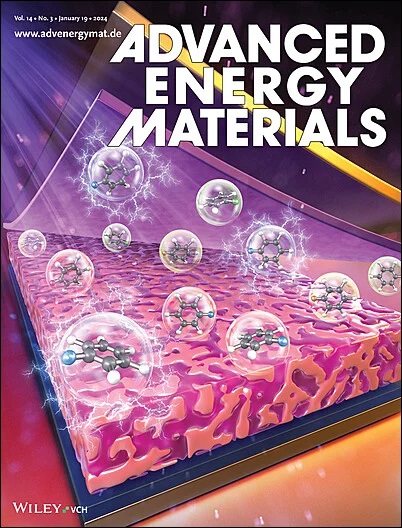Force‐Field Regulation Engineered Heterogeneous Graphene Micro‐Aerogels as Versatile Platforms for High‐Mass‐Loading Energy Storage
IF 24.4
1区 材料科学
Q1 CHEMISTRY, PHYSICAL
引用次数: 0
Abstract
Achieving high areal energy density requires the development of advanced electrodes capable of maintaining excellent performance under high mass‐loading conditions. Herein, a novel force‐field regulation strategy has been proposed to fabricate graphene oxide/exfoliated graphene heterogeneous micro‐aerogels (GM) electrodes with precisely engineered channel structures and interconnected conductive frameworks. This innovative design effectively mitigates the limitations of conventional graphene aerogels (GA) and graphene films (EGF), such as prolonged ion transport paths and severe internal potential gradients, particularly under high mass‐loading. As a result, GM electrode, with a high mass loading of 20 mg cm力场调节工程非均相石墨烯微气凝胶作为高质量负载储能的通用平台
实现高面能密度需要开发先进的电极,能够在高质量负载条件下保持优异的性能。本文提出了一种新的力场调节策略,用于制造具有精确工程通道结构和相互连接的导电框架的氧化石墨烯/脱落石墨烯非均质微气凝胶(GM)电极。这种创新的设计有效地缓解了传统石墨烯气凝胶(GA)和石墨烯薄膜(EGF)的局限性,例如离子传输路径延长和内部电位梯度严重,特别是在高质量负载下。结果表明,在20 mg cm−2的高质量负载下,GM电极在200 s的工作时间内表现出2.53 F cm−2的电容,在5 s的较短时间内保持58.7%的电容保持率,明显优于GA和EGF电极。此外,GM架构可以作为承载氧化还原活性faradic材料(如PANI, MnO2和Co(OH)2)的通用平台,实现高达16.9 F cm−2的卓越面电容,展示其在储能应用中的通用性和可扩展性。通过多尺度表征,电化学分析和有限元模拟,全面阐明了驱动GM电极优越性能的潜在机制,为下一代高质量负载储能系统的设计提供了强大的框架。
本文章由计算机程序翻译,如有差异,请以英文原文为准。
求助全文
约1分钟内获得全文
求助全文
来源期刊

Advanced Energy Materials
CHEMISTRY, PHYSICAL-ENERGY & FUELS
CiteScore
41.90
自引率
4.00%
发文量
889
审稿时长
1.4 months
期刊介绍:
Established in 2011, Advanced Energy Materials is an international, interdisciplinary, English-language journal that focuses on materials used in energy harvesting, conversion, and storage. It is regarded as a top-quality journal alongside Advanced Materials, Advanced Functional Materials, and Small.
With a 2022 Impact Factor of 27.8, Advanced Energy Materials is considered a prime source for the best energy-related research. The journal covers a wide range of topics in energy-related research, including organic and inorganic photovoltaics, batteries and supercapacitors, fuel cells, hydrogen generation and storage, thermoelectrics, water splitting and photocatalysis, solar fuels and thermosolar power, magnetocalorics, and piezoelectronics.
The readership of Advanced Energy Materials includes materials scientists, chemists, physicists, and engineers in both academia and industry. The journal is indexed in various databases and collections, such as Advanced Technologies & Aerospace Database, FIZ Karlsruhe, INSPEC (IET), Science Citation Index Expanded, Technology Collection, and Web of Science, among others.
 求助内容:
求助内容: 应助结果提醒方式:
应助结果提醒方式:


